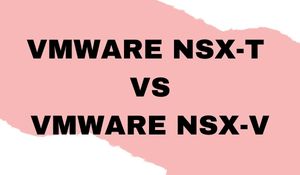
VMware NSX in Brief
NSX is a software-defined networking solution to tackle the rapid growth of data center networking needs VMware is created. The main function is to provide virtualized network creation and management through the NSX Manager, a component of NSX Data Centre. In addition, VMware NSX provides decisive network security features to ensure the virtual environment is prudent. With NSX, no changes to the underlying hardware are necessary. Similar to how VMs work Network provisioning and connection between virtual networks are withdrawn from the hardware. From Layer 2 to Layer 7 of the OSI model, NSX virtualizes switches, routers, firewalls, and other network services. This process saves time, effort, and costs, enabling large companies to centralize and automate network management and control. Comparing Licensing where interestingly, the licensing for NSX-V and NSX-T are the exact same license. So, if you have the license key for NSX-V, you can plug this license key into NSX-T and it will work. At least at this point, VMware has not differentiated the solutions from a licensing perspective. Depending on the product you chose, VMware NSX is suitable for all infrastructure types:
- Multi-cloud environments
- On-premises data centres
- Bare metal servers
- Containerized workloads
VMware NSX is an advanced SDN solution with two variants:
- NSX-V
- NSX-T

What is NSX-V?
NSX-V architecture V is abbreviated as vSphere features deployment reconfiguration, rapid provisioning, and destruction of on-demand virtual networks. This product depends on VMware vSphere and connection with vCenter. Once NSX-V pairs with vCenter, the integration with vSphere is consistent. With NSX-V we cannot have multiple vCenters. In the case of having multiple vCentre, should have multiple NSX managers, which can be challenging in multi-cloud environments. The maintenance can become unwidely and demanding. As companies transition to the cloud for handling workloads, the VMware NSX-V solution proves inappropriate for many clients. Now more of a legacy VMware product, NSX-V is being replaced by NSX-T.
What is NSX-T?
VMware NSX-Transformers is a successor to NSX-V and offers options to build a highly agile SDN infrastructure. The product brings network virtualization to bare-metal and containerized workloads, multi-cloud, and multi-hypervisor environments. NSX-T supports cloud-native applications, network virtualization stack for OpenStack, Kubernetes, KVM, Docker, etc. Many consider NSX-T as an upgrade of NSX-V. It is true that the main idea behind both products is the same. However, VMware built NSX-T from the ground up, and what lies under the hood differs completely from NSX-V. The main benefit is that NSX-T can be deployed in heterogeneous environments with many different components. NSX-T is not under the confines of the vCenter deployment. You can have multiple vCenter servers and use one NSX manager as a single pane of glass for controlling your virtual network. Or, you do not have to deploy a vCenter at all. Instead, you can choose ESXi as the operating system in the NSX-T GUI.
VMware NSX-V vs. NSX-T Comparisons
- Basic Functions: NSX-V offers profuse features such as deployment reconfiguration, rapid provisioning, and destruction of any on-demand virtual network. Utilizing the vSphere distributed switch allows a single virtual switch to connect to multiple hosts in a cluster. NSX-T offers users an agile software-defined infrastructure. It is suitable for building cloud-native application environments. It also provides simplicity for operations in networking and security. It has built-in support for multiple clouds, multi-hypervisor environments, and bare-metal workloads.
- Origins: NSX-V is built around the VMware vSphere environment. It was initially released in 2012. NSX-T originates from the vSphere ecosystem, but it is built from scratch and designed to address some of the use cases which is not covered by NSX-V.
- Coverage: NSX-V architecture was built with on-premises of physical network vSphere deployments in mind and one vCenter Server. Meanwhile, NSX-T extends its coverage to include multiple hypervisors, containers, cloud environments, and bare metal servers. It also has some limitations with gaps concerning micro-segmentation.
- Hypervisor Support: vSphere network virtualization stack is supported. In addition to the vSphere stack, NSX-T also supports OpenStack, Kubernetes, Docker, KVM, etc.
- Migration: Migration is not possible from NSX-T to NSX-V. Whereas NSX-T Manager has a migration utility built in for users who want to migrate from NSX-V to NSX-T.
- Working with NSX Manager: NSX-V Manager works with only one vCenter Server. Runs on Photon OS. Whereas, NSX-T Manager supports working with multiple vCenter at once. Runs on the Ubuntu operating system.
- Deployment: Can be deployed only as an ESXi VM. But in NSX-T Manager acts as a standalone solution and can be deployed as an ESXi or KVM VM.
- Overlay Encapsulation Protocols: NSX-V uses the VXLAN encapsulation protocol. Whereas NSX-T uses Geneve, a more advanced protocol.
- Logical Switch Replication Modes: In NSXV uses Unicast, Multicast, and Hybrid modes. But in NSX-T use only mode Unicast Two-tier or Head mode.
- Routing: NSX-V uses network edge security and gateway services which are used to isolate virtualized networks. NSX Edge is installed both as a logical distributed router as well as an edge services gateway. NSX-T routing is designed for cloud environments and multi-cloud use. It is designed for multi-tenancy use cases and is for heterogeneous environments.

Conclusion
NSX-T and NSX-V offers full feature sets, provides an agile and secure environment. Both solves many virtualization issues. NSX-V is the original network and security virtualization platform that was huge chief for several years. As businesses are grows, there were fewer companies with single on-premises data centers and more cloud-based IT environments. This is where NSX-T come into picture. Its constant expansion of features and multi-site and cloud support is making NSX-V outdated. Now, VMware labels their NSX solution as VMware NSX Data Center. With the necessary tools for moving and handling your data, regardless of the underlying physical network, NSX helps you adjust to the constant changes in applications. The choice you make depends on which NSX features meet your business needs. This Gologica’s online course has been planned such that it is simple for you to get and grow your VMware NSX abilities rapidly. This preparation empowers you to work adequately. Happy Learning!!
Author Bio

Kavya Sathvik, A content strategist at Gologica. She has 2 years of experience in content writing. Passionate about writing technical content and also creating an effective content strategy for brands and blogs. Contact her: Linkedin
